Zoanthids (phylum Cnidaria, class Anthozoa, subclass Hexacorallia, order Zoantharia) are colonial animals with radially symmetrical bodies, resembling sea anemones clustering together in a colony, and hence they are also called colonial anemones. Each animal (or polyp) is made up of a stomach (coelenteron) housed in a cylindrical body column, and at the tip of the column is a mouth on a disc-like structure (oral disc) surrounded by tentacles. The tentacles occur in multiples of six, and hence they are in the subclass Hexacorallia.

These colonial animals are connected at the base by a common fleshy tissue, and there are channels within the common tissue linking the stomachs of the individual polyps. Zoanthids do not have an anus, and hence the mouth performs both functions of ingesting food and removing waste. To feed, they usually capture plankton and tiny decaying matter with their stinging tentacles - like other cnidarians, they possess explosive, harpoon-like cells (called cnidocytes). Each cnidocyte contains a secretory organelle (cnidae), which can be a nematocyst that discharges a harpoon-like stinger carrying toxins, a ptychocyst that discharges sticky substances, or a spirocyst that discharges lasso-like threads. Hence while cnidocytes are often called "stinging cells", they do perform other functions apart from stinging.
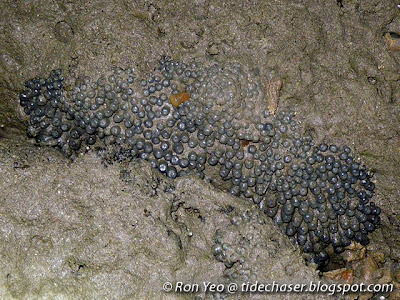
The stings of zoanthids are, however, usually too weak to deter predators. Hence, they usually retract their tentacles in the body column when disturbed to protect themselves from predators. The tentacles are also retracted during low tide to prevent desiccation. Many zoanthids are also poisonous, though some predators have adapted such that they can still consume the zoanthids safely.
IMPORTANT: Zoanthids should never be handled with bare hands - you just need a tiny wound on your hand, or accidentally rub your eyes or mouth after touching them for the toxin to get into your body. For the most toxic zoanthids, it is suggested that just 64 microgram [one millionth (1/1,000,000) of a gram] of the toxic chemical entering a human's blood vessels is enough to kill.

Sometimes, bleached zoanthids that are white in colour can be seen. This happens because the base colour of the zoanthids usually come from the unicellular algae, zooxanthellae (Symbiodinium spp.), living inside their tissues. Due to environmental stress, the zoanthids may expel their zooxanthellae or the latter may leave their host, thus resulting in the whitish appearance. The zooxanthellae play an important role by producing food through photosynthesis and share the food with the host zoanthids, and in return get shelter and nutrients (waste products of the corals). If the situation does not improve and the zoanthids cannot recruit new zooxanthellae to replace the lost ones, they may die. One of the main causes of coral bleaching is the rise in water temperatures.
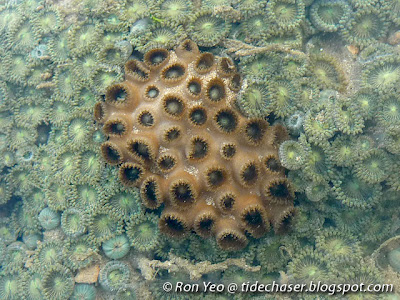
Sometimes, more than one species of zoanthids can be found over the same area.

Here is another example of more than one species of zoanthids growing together.
A study by Dr James D. Reimer in 2009 recorded four species of previously known zoanthids and one possible new species in Singapore. The identification of the following zoanthids is hence based on the paper he published with Dr Peter A. Todd.
Family Sphenopidae
Zoanthids from this family generally incorporate sand and other marine debris into their tissues. Many members also contain palytoxin, one of the most toxic chemical found in nature. It is believed that the toxin is not produced by the zoanthids, but by symbiotic bacteria living inside them. The toxin destroys protein (hence body cells), and studies suggest that 64 microgram [one millionth (1/1,000,000) of a gram] is enough to kill a human. There was even a Hawaiian legend related to palytoxin. Here is a summary of the legend from Wikipedia:
It was only in 1971 when palytoxin was isolated from a zoanthid, Palythoa sp., that scientist assessed that the limu-make-o-Hana was not a seaweed but a zoanthid.
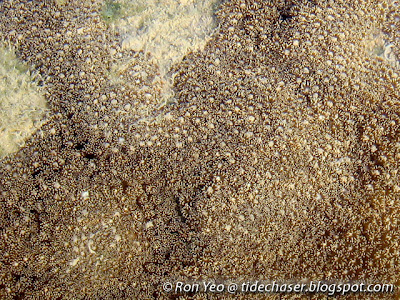
Palythoa tuberculosa, commonly called the Carpet Colonial Anemones or Sea Mat Zoanthids in the diving or aquarium trade, got its common names from the carpet-like appearance when the tentacles are extended.
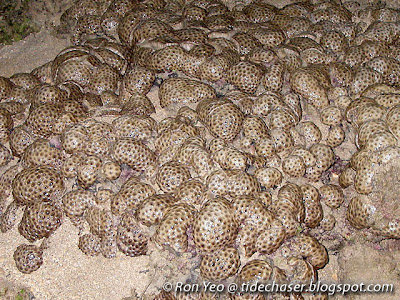
When exposed during low tide, the colony has a lumpy, rubber-like appearance. The colony feels rough (remember not to touch with bare hands) as it incorporates the sediment to build the tissue mass. The polyps retract completely into the body tissue, and hence no protruding body columns will be seen.

The colour of the colony can be light to dark brown, or yellow to orange.

According to Dr Reimer, obvious radiating gill-like structures (septae) can be seen on the oral disc, but unfortunately my photos are not close-up enough to see that. The oral disc is about 6-16mm wide.
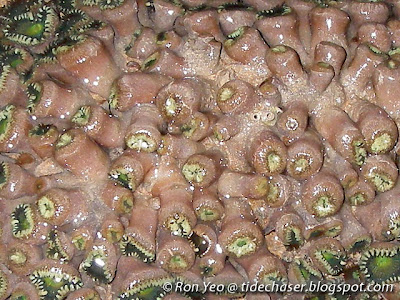
Palythoa mutuki, or the Mutuki Colonial Anemone, forms a network of fleshy branches (stolons) connecting the polyps instead of the massive encrusting body tissue seen in the previous species. The body columns of the polyps do not retract completely into the stolons, and can be seen obviously when they are exposed during low tide. The oral discs and the tentacles can retract completely into the body column though. The body also incorporates sand and other marine debris.

The colour of the body column ranges from pinkish brown to light brown. The oral disc may be bright to dark green, or sometimes, brownish.

The oral disc is rather broad - between 10-18mm wide, and obvious septae (gill-like radiating structures) can be seen. The tentacles taper to pointed tips.
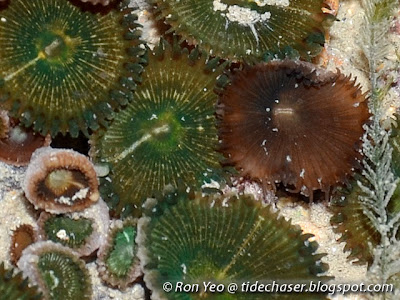
Dr Reimer reported in his paper that another species of Palythoa which has dark-brown oral disc with barely visible septae, which he tentatively named as Palythoa sp. "singapura". Interestingly, this zoanthid harbours the same type of zooxanthellae previously only found in Zoanthus species, but more specimens need to be studied before it can be confirmed to be a new species. I have seen a brown Palythoa sp. growing among some Palythoa mutuki which are dark brown with less obvious septae. Not sure if that could be the same as this unknown species?
On a separate note, one species of Palythoa, Palythoa singaporensis, was discovered in and named after Singapore. It is still regarded as a valid species, but has not been seen in recent surveys.
Family Zoanthidae
Zoanthids from this family generally do not incorporate sand and marine debris into their body tissue, and the polyps do not retract completely. According to Dr Reimer's paper, two species have been found among Singapore's Southern Islands. It is possible that there are more species waiting to be uncovered, especially in the areas no surveyed.

Zoanthus vietnamensis, or the Vietnamese Zoanthid, usually form mats over soft substrates, or occur as a thin encrusting layer over rocks. There are a few colour variations, and the ones with the pinkish tips are most easily recognised.

So are the specimens with pink oral discs.

Specimens of other colour variations can be hard to differentiate from other Zoanthus species. They generally have obvious septae on their oral discs though.

The size of the oral disc can range from 4-14mm, according to Dr Reimer's paper. The oral disc can be green, but that can be confused with other Zoanthus species with similar colours.
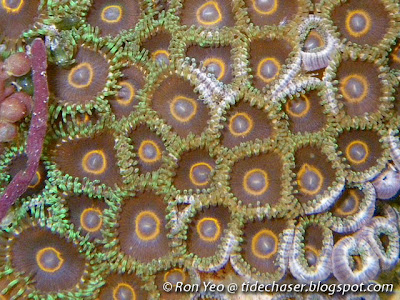
Zoanthus sansibaricus is the other Zoanthus species recorded during the 2009 survey. It tends to have smaller polyps, with the oral disc between 4-8mm, and the tentacles are relatively longer when fully extended. The oral disc can come in a variety of colours, including brown, red, orange, blue, green etc, but the septae is not obvious.
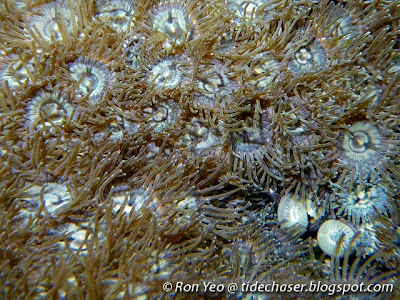
But I often wonder if there could be more variations or species, as the one above has somewhat obvious septae, relatively long tentacles, and small polyps. Could it be a variation of Zoanthus sansibaricus or another species altogether? Identifying Zoanthus species in the field is thus very difficult and rather confusing.
More studies definitely need to be done on the zoanthids of Singapore.
References

These colonial animals are connected at the base by a common fleshy tissue, and there are channels within the common tissue linking the stomachs of the individual polyps. Zoanthids do not have an anus, and hence the mouth performs both functions of ingesting food and removing waste. To feed, they usually capture plankton and tiny decaying matter with their stinging tentacles - like other cnidarians, they possess explosive, harpoon-like cells (called cnidocytes). Each cnidocyte contains a secretory organelle (cnidae), which can be a nematocyst that discharges a harpoon-like stinger carrying toxins, a ptychocyst that discharges sticky substances, or a spirocyst that discharges lasso-like threads. Hence while cnidocytes are often called "stinging cells", they do perform other functions apart from stinging.

The stings of zoanthids are, however, usually too weak to deter predators. Hence, they usually retract their tentacles in the body column when disturbed to protect themselves from predators. The tentacles are also retracted during low tide to prevent desiccation. Many zoanthids are also poisonous, though some predators have adapted such that they can still consume the zoanthids safely.
IMPORTANT: Zoanthids should never be handled with bare hands - you just need a tiny wound on your hand, or accidentally rub your eyes or mouth after touching them for the toxin to get into your body. For the most toxic zoanthids, it is suggested that just 64 microgram [one millionth (1/1,000,000) of a gram] of the toxic chemical entering a human's blood vessels is enough to kill.

Sometimes, bleached zoanthids that are white in colour can be seen. This happens because the base colour of the zoanthids usually come from the unicellular algae, zooxanthellae (Symbiodinium spp.), living inside their tissues. Due to environmental stress, the zoanthids may expel their zooxanthellae or the latter may leave their host, thus resulting in the whitish appearance. The zooxanthellae play an important role by producing food through photosynthesis and share the food with the host zoanthids, and in return get shelter and nutrients (waste products of the corals). If the situation does not improve and the zoanthids cannot recruit new zooxanthellae to replace the lost ones, they may die. One of the main causes of coral bleaching is the rise in water temperatures.

Sometimes, more than one species of zoanthids can be found over the same area.

Here is another example of more than one species of zoanthids growing together.
A study by Dr James D. Reimer in 2009 recorded four species of previously known zoanthids and one possible new species in Singapore. The identification of the following zoanthids is hence based on the paper he published with Dr Peter A. Todd.
Family Sphenopidae
Zoanthids from this family generally incorporate sand and other marine debris into their tissues. Many members also contain palytoxin, one of the most toxic chemical found in nature. It is believed that the toxin is not produced by the zoanthids, but by symbiotic bacteria living inside them. The toxin destroys protein (hence body cells), and studies suggest that 64 microgram [one millionth (1/1,000,000) of a gram] is enough to kill a human. There was even a Hawaiian legend related to palytoxin. Here is a summary of the legend from Wikipedia:
According to an ancient Hawaiian legend, on the island of Maui near the harbour of Hana there was a village of fishermen haunted by a curse. Upon their return from the sea one of the fishermen went missing. One day, enraged by another loss, the fishermen assaulted a hunchbacked hermit deemed culprit of the town's misery. While ripping off the cloak from the hermit the villagers were shocked because they uncovered rows of sharp and triangular teeth within huge jaws. A shark god had been caught. It was clear that the missing villagers had been eaten by the god on their journeys to the sea. The men mercilessly tore the shark god into pieces, burned him and threw the ashes into a tide pool near the harbour of Hana. Shortly after, a thick brown moss started to grow on the walls of the tide pool causing instant death to victims hit by spears smeared with the moss. Thus was the evil of the demon. The moss growing in the cursed tide pool became known as "limu-make-o-Hana" which literally means "seaweed of death from Hana." The Hawaiians believed that an ill curse came over them if they tried to collect the deadly seaweed.
It was only in 1971 when palytoxin was isolated from a zoanthid, Palythoa sp., that scientist assessed that the limu-make-o-Hana was not a seaweed but a zoanthid.

Palythoa tuberculosa, commonly called the Carpet Colonial Anemones or Sea Mat Zoanthids in the diving or aquarium trade, got its common names from the carpet-like appearance when the tentacles are extended.

When exposed during low tide, the colony has a lumpy, rubber-like appearance. The colony feels rough (remember not to touch with bare hands) as it incorporates the sediment to build the tissue mass. The polyps retract completely into the body tissue, and hence no protruding body columns will be seen.

The colour of the colony can be light to dark brown, or yellow to orange.

According to Dr Reimer, obvious radiating gill-like structures (septae) can be seen on the oral disc, but unfortunately my photos are not close-up enough to see that. The oral disc is about 6-16mm wide.

Palythoa mutuki, or the Mutuki Colonial Anemone, forms a network of fleshy branches (stolons) connecting the polyps instead of the massive encrusting body tissue seen in the previous species. The body columns of the polyps do not retract completely into the stolons, and can be seen obviously when they are exposed during low tide. The oral discs and the tentacles can retract completely into the body column though. The body also incorporates sand and other marine debris.

The colour of the body column ranges from pinkish brown to light brown. The oral disc may be bright to dark green, or sometimes, brownish.

The oral disc is rather broad - between 10-18mm wide, and obvious septae (gill-like radiating structures) can be seen. The tentacles taper to pointed tips.

Dr Reimer reported in his paper that another species of Palythoa which has dark-brown oral disc with barely visible septae, which he tentatively named as Palythoa sp. "singapura". Interestingly, this zoanthid harbours the same type of zooxanthellae previously only found in Zoanthus species, but more specimens need to be studied before it can be confirmed to be a new species. I have seen a brown Palythoa sp. growing among some Palythoa mutuki which are dark brown with less obvious septae. Not sure if that could be the same as this unknown species?
On a separate note, one species of Palythoa, Palythoa singaporensis, was discovered in and named after Singapore. It is still regarded as a valid species, but has not been seen in recent surveys.
Family Zoanthidae
Zoanthids from this family generally do not incorporate sand and marine debris into their body tissue, and the polyps do not retract completely. According to Dr Reimer's paper, two species have been found among Singapore's Southern Islands. It is possible that there are more species waiting to be uncovered, especially in the areas no surveyed.

Zoanthus vietnamensis, or the Vietnamese Zoanthid, usually form mats over soft substrates, or occur as a thin encrusting layer over rocks. There are a few colour variations, and the ones with the pinkish tips are most easily recognised.

So are the specimens with pink oral discs.

Specimens of other colour variations can be hard to differentiate from other Zoanthus species. They generally have obvious septae on their oral discs though.

The size of the oral disc can range from 4-14mm, according to Dr Reimer's paper. The oral disc can be green, but that can be confused with other Zoanthus species with similar colours.

Zoanthus sansibaricus is the other Zoanthus species recorded during the 2009 survey. It tends to have smaller polyps, with the oral disc between 4-8mm, and the tentacles are relatively longer when fully extended. The oral disc can come in a variety of colours, including brown, red, orange, blue, green etc, but the septae is not obvious.

But I often wonder if there could be more variations or species, as the one above has somewhat obvious septae, relatively long tentacles, and small polyps. Could it be a variation of Zoanthus sansibaricus or another species altogether? Identifying Zoanthus species in the field is thus very difficult and rather confusing.
More studies definitely need to be done on the zoanthids of Singapore.
References
- Burnett, W. J., J. A. H. Benzie, J. A. Beardmore, & J. S. Ryland. 1997. Zoanthids (Anthozoa, Hexacorallia) from the Great Barrier Reef and Torres Strait, Australia: systematics, evolution and a key to species. Coral Reefs 16(1): 55-68.
- Erhardt, H. & D. Knop. 2005. Corals: Indo-Pacific Field Guide. IKAN-Unterwasserachiv, Frankfurt. 305 pp.
- Fautin, D. G. 2011. Hexacorallians of the World. Retrieved Jan 8, 2013, from http://geoportal.kgs.ku.edu/hexacoral/anemone2/index.cfm
- Forino, M. et al. 2010. Palytoxins: A still haunting Hawaiian curse. Phytochemistry Reviews 9 (4): 491–500.
- Moore, R. E. & P. J. Scheuer. 1971. Palytoxin - New Marine Toxin from a Coelenterate. Science 172 (3982): 495–498.
- Reimer, J.D. & P. A. Todd. 2009. Preliminary molecular examination of zooxanthellate zoanthids (Hexacorallia: Zoantharia) and associated zooxanthellae (Symbiodinium spp.) diversity in Singapore. Raffles Bulletin of Zoology Suppl. 22: 103-120.
- Rhodes, L., R. Munday, L. Briggs. 2008. Ostreopsis siamensis and palytoxin-related compounds in New Zealand: a risk to human health? In: Moestrup, Ø. (Ed.), Proceedings of the 12th International Conference on Harmful Algae. ISSHA and Intergovernmental Oceanographic Commission of UNESCO. Copenhagen, Denmark. pp. 326–329
- Ruppert, E.E. and R.D. Barnes. 1991. Invertebrate Zoology (International Edition). Saunders College Publishing. U.S.A. 1056 pp.
- Palytoxin. Wikipedia. Retrieved Jan 9, 2013, from http://en.wikipedia.org/wiki/Palytoxin
- World Register of Marine Species. 2012. Retrieved Jan 8, 2013, from http://www.marinespecies.org.

No comments:
Post a Comment